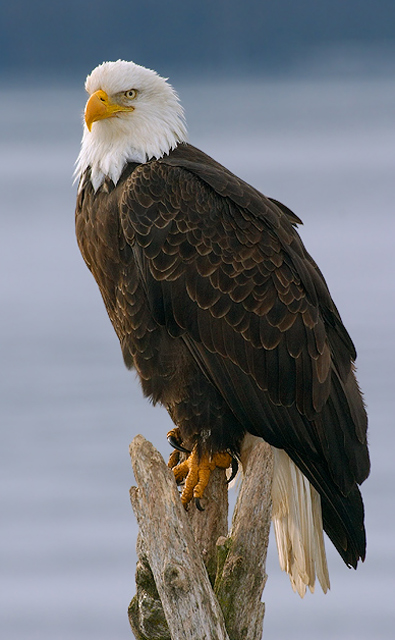The Bald Eagle was made the national symbol of the United States in 1782. The Bald Eagle was threatened with extinction due to the use of pesticides, particularly DDT, loss of habitat, and hunting. It was classified as endangered in 1978 under the Endangered Species Act. Federal protection included reintroductions, habitat protection, fines for disturbance or injury, captive breeding programs, monitoring, relocation, and public outreach. By 1995, the Bald Eagle was changed to threatened. As of spring 2006, the Bald Eagle is under revision to be removed from the list completely.
The name Bald Eagle comes from the word "piebald" which means patches with contrasting colors (Cornell Lab of Ornithology 2003). In addition, the origin of the word "bald" means white, instead of hairless (Bald Eagle Information 2006). The Bald Eagle is native to North America and is considered a "fish-eagle" (Elphick et al. 2001). This species may not migrate if open waters near nest do not freeze in colder seasons (University of Michigan Museum of Zoology 2006). Bald Eagles may maintain the same mate for some time and are known to copulate outside of the breeding season (University of Michigan Museum of Zoology 2006).
Length: 31 inches (78.75 cm), wingspan 80 inches (203.2 cm) (Kaufman 2000).
Physical characteristics:
Male and female adults have a dark brownish/black body, with a white head and tail. The thick curved bill and feet are yellow in color. Immatures are dark brown all over, with white mottling. Immatures take four years to reach adult plumage.
Voice:
"A weak, harsh chatter" (Kaufman 2000).
Breeding habitat:
Open areas with lakes, rivers, or coasts (Ehrlich et al. 1988).
Mating system:
Monogamous. Courtship displays are performed in the air, locking talons and descending in numerous somersaults (Ehrlich et al. 1988).
Nest:
The male and female share responsibilities in building the nest. The nest is usually made in a tall coniferous tree 30-60 inches (9.1m-18.3m) above ground. The nest is a platform type nest which is a large nest, without a depression for the eggs. The nest is made of large sticks and vegetation, and is lined with fine materials (Ehrlich et al. 1988).
Eggs:
Large unmarked bluish-white eggs, 3.0 inches (76 mm). There are typically two eggs in a clutch, but one to three has been seen. Bald Eagles have one brood a year (Ehrlich et al. 1988).
Chick development:
The male and female help in incubation which lasts 34-36 days. The young are born semi-altricial, they already have down and eyes are open. The male and female bald eagle share responsibilities in tending to the young, which fledge in 70-80 days (Ehrlich et al. 1988).
Diet:
It primarily feed on fish, particularly salmon up to 15 lbs. The Bald Eagle will also feed on small mammals, waterfowl, seabirds, and carrion. It hunts by searching at high and low altitudes for prey, then swoops down and grabs prey out of the water with its talons (Ehrlich et al. 1988).
Conservation Biology:
The Bald Eagle was once threatened with extinction due to human impacts. Populations are becoming more stable and in Alaska, they remain numerous. Conservation efforts were beneficial to this species. Currently, populations are still being watched carefully.
Breeding Distribution:
In the past, it was only known to breed throughout Alaska and most of Canada. It is now also breeding in the lower 48 states in scattered locations of open bodies of water and is known to have bred in Tennessee (Tennessee Ornithological Society 2006) and North Carolina.
Rangewide Status:
This species is listed as threatened on a global scale (LeGrand and Hall 1999).
Winter:
They winter in coastal Baja in the past (Ehrlich et al. 1988). Now they will also winter in much of the lower 48 states, excluding many eastern states, such as North Carolina and far eastern Tennessee (Cornell Lab of Ornithology 2003).
In Park:
The Bald Eagle is an occasional migrant in the park (Alsop 2003). Stupka (1963) stated that from July 1934 to January 1961, there was an average of one record every two years of a Bald Eagle. The Bald Eagle has been documented throughout the park at high elevations such as Newfound Gap, as well as various rivers and reservoirs park (Park Observations). They have nested south of the park beside some reservoirs.
References:
Alsop, F. J. III. 1991. Birds Of The Smokies. Great Smoky Mountains History Association, Gatlinburg, Tennessee.
Bald Eagle Information. 2006. Available at American Bald Eagle Information. Accessed on March 30, 2006.
Cornell Lab of Ornithology. 2003. Available at All About Birds: Bald Eagle. Accessed on March 30, 2006.
Elphick, C., J. B. Dunning, Jr., and D.A. Sibley, eds. 2001. The Sibley Guide to Bird Life and Behavior. Alfred A. Knopf, New York.
Kaufman, K. 2000. Birds of North America. Hillstar Editions L. C. New York.
Tennessee Ornithological Society. 2006. Available at The Official Checklist of the Birds of Tennessee. Accessed on March 30, 2006.
University of Michigan Museum of Zoology. 2006. Available at Animal Diversity Web: Haliaeetus leucocephalus (Bald Eagle). Accessed on March 30, 2006.
Withers, D. I., K. Condict, and R. McCoy. 2004. A Guide to the Rare Animals of Tennessee. Division of Natural Heritage, Tennessee Department of Environment and Conservation.
Gough, G. A., Sauer, J. R., Iliff, M. Patuxent Bird Identification Infocenter. 1998. Version 97.1. Patuxent Wildlife Research Center, Laurel, MD. http://www.mbr-pwrc.usgs.gov/id/framlst/infocenter.html.
LeGrand, H. E. and Hall, S. P., compilers. 1999. Natural Heritage Program List of the Rare Animals of North Carolina. North Carolina Natural Heritage Program, Division of Parks and Recreation, North Carolina Department of Environment and Natural Reso
Animalia
Chordata
Aves
Accipitriformes
Accipitridae
Phenology
(Linnaeus)

